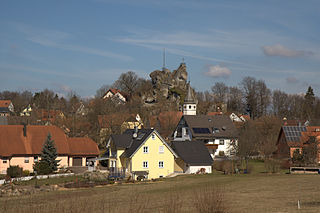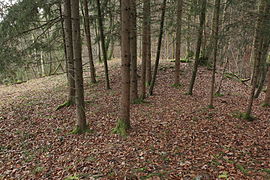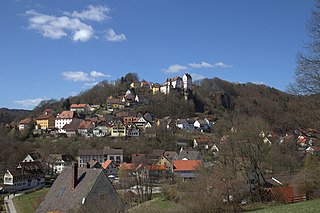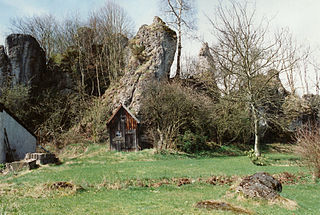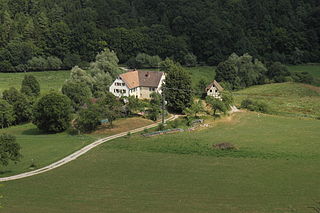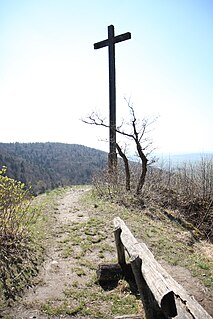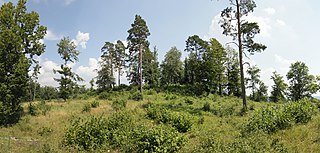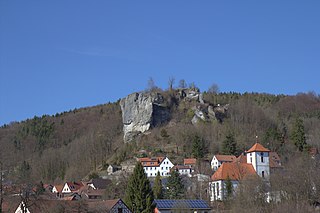| Burgstall Altes Schloss | |
|---|---|
| Pretzfeld-Oberzaunsbach-"Zaunsbacher Berg" | |
The burgstall of the Altes Schloss. Castle rock seen from the NW (December 2014) | |
| Coordinates | 49°43′27″N11°14′30″E / 49.724092°N 11.241601°E Coordinates: 49°43′27″N11°14′30″E / 49.724092°N 11.241601°E |
| Type | hill castle, hillside location |
| Code | DE-BY |
| Height | 450 m above sea level (NN) |
| Site information | |
| Condition | burgstall , neck ditch |
| Site history | |
| Built | Medieval |
The burgstall of the Altes Schloss ("Old Castle", German : Burgstall Altes Schloss) is the site of a, now levelled, mediaeval castle on the hillside of the Zaunsbacher Berg above the valley of the Trubach. It lies around 1,000 metres south-shouteast of the village of Oberzaunsbach in the Upper Franconian municipality of Pretzfeld in the south German state of Bavaria.

A burgstall is a German term referring to a castle of which so little is left that its appearance cannot effectively be reconstructed. It has no direct equivalent in English, but may be loosely translated as "castle site". Variations in the literature include Burgstelle, Altburgstelle, die Burgställe (plural), Burgstähl (archaic) or abgegangene Burg. In German castle studies, a burgstall is a castle that has effectively been levelled, whereas a "ruin" (Ruine) still has recognisable remnants of the original castle above the level of the ground.

German is a West Germanic language that is mainly spoken in Central Europe. It is the most widely spoken and official or co-official language in Germany, Austria, Switzerland, South Tyrol (Italy), the German-speaking Community of Belgium, and Liechtenstein. It is also one of the three official languages of Luxembourg and a co-official language in the Opole Voivodeship in Poland. The languages which are most similar to German are the other members of the West Germanic language branch: Afrikaans, Dutch, English, the Frisian languages, Low German/Low Saxon, Luxembourgish, and Yiddish. There are also strong similarities in vocabulary with Danish, Norwegian and Swedish, although those belong to the North Germanic group. German is the second most widely spoken Germanic language, after English.

Trubach is a river of Bavaria, Germany. It flows into the Wiesent near Pretzfeld.
Contents
No historical or archaeological information exists about this castle. It has been roughly dated to the mediaeval period. [1] All that has survived of the castle is a neck ditch which is probably largely natural. The site is listed as heritage site number D-4-6233-0072: Mittelalterlicher Burgstall. [2]
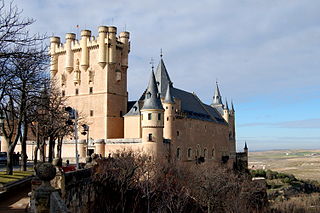
A castle is a type of fortified structure built during the Middle Ages by predominantly the nobility or royalty and by military orders. Scholars debate the scope of the word castle, but usually consider it to be the private fortified residence of a lord or noble. This is distinct from a palace, which is not fortified; from a fortress, which was not always a residence for royalty or nobility; and from a fortified settlement, which was a public defence – though there are many similarities among these types of construction. Usage of the term has varied over time and has been applied to structures as diverse as hill forts and country houses. Over the approximately 900 years that castles were built, they took on a great many forms with many different features, although some, such as curtain walls and arrowslits, were commonplace.
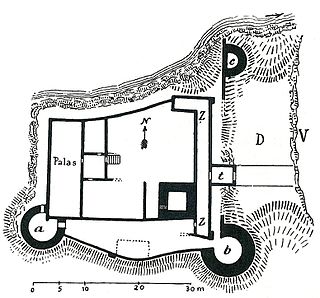
A neck ditch, sometimes called a throat ditch, is a dry moat that does not fully surround a castle, but only bars the side that is not protected by natural obstacles. It is often an important element in the defensive system of hill castles, especially in Germany and other parts of Central Europe.




